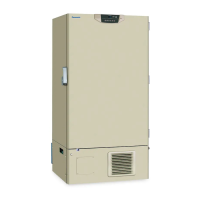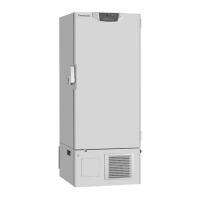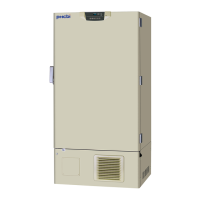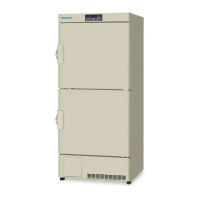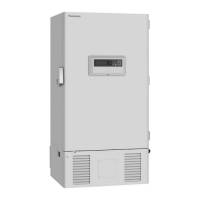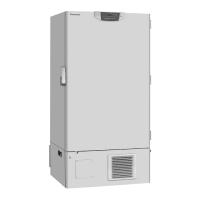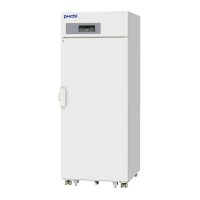How to unlock temperature settings on Panasonic MDF-U334 Freezer?
- LLeslie GrantAug 7, 2025
If your Panasonic Freezer isn't accepting temperature setting changes, the key lock may be ON. Set the key lock to OFF mode to adjust the temperature.
How to unlock temperature settings on Panasonic MDF-U334 Freezer?
If your Panasonic Freezer isn't accepting temperature setting changes, the key lock may be ON. Set the key lock to OFF mode to adjust the temperature.
Why is the cooling poor in my Panasonic MDF-U334 Freezer?
Poor cooling in your Panasonic Freezer can stem from several causes. First, make sure the ambient temperature isn't too high and that the freezer door is firmly closed. Check for excessive frost buildup on the chamber wall and remove it if necessary. Ensure the set temperature is correctly inputted. Avoid direct sunlight and nearby heating sources. Verify the rubber cap and insulation for the access port are correctly set. Finally, avoid putting too many unfrozen items into the freezer at once.
What to do if the Panasonic MDF-U334 Freezer chamber is not cooling at all?
If your Panasonic Freezer's chamber isn't cooling, start by checking the circuit breaker. If the voltage is too low, call an electrician. Make sure the power switch is turned ON. If you've stored a large amount of items at once, try reducing the quantity. Also, the freezer may be in defrost mode, so wait until it's finished.
Why is my Panasonic MDF-U334 Freezer making noise?
Noises from your Panasonic Freezer can arise from a few things. Ensure the freezer is on a sturdy, level floor, adjusted with leveling feet. Check that nothing is touching the frame. If the freezer just started, give it time to stabilize. High chamber temperatures due to a large load can also cause noise; reducing the load may help. The noise should lessen as the chamber cools.
Describes external and internal components like the door, handle, and storage.
Details on leveling feet, casters, access port, and alarm terminals.
Identifies the control panel and its primary indicators.
Explanation of the alarm lamp and digital temperature indicator.
Details on the function of various setting, defrost, and alarm keys.
Includes unpacking, leveling, and fixing the unit.
Covers grounding and installing a short circuit breaker.
Connecting power, switching on, and testing alarms.
Procedures for setting desired temperature and loading items.
Press SET key to enter temperature setting mode.
Use digit and value shift keys to set desired temperature.
Press SET key again to store the new temperature.
Procedure to activate the key lock function.
Procedure to deactivate the key lock function.
Describes the contact output when the unit is operating normally.
Describes the contact output during an alarm condition.
Procedure to set the high temperature alarm threshold.
Procedure to set the low temperature alarm threshold.
Set the time before alarms resume after being silenced.
Details on high/low temp, power failure, and battery status alarms.
Covers key lock status and sensor abnormality indications.
Information on compressor protection and fan motor checks.
Instructions for cleaning the unit's interior and exterior surfaces.
Steps for manually defrosting the freezer chamber.
Addresses issues where the chamber is not cooled or cooling is poor.
Covers problems with temperature setting changes and unit noise.
Procedures for recycling the battery and decontaminating the unit.
Steps for removing and disposing of the nickel-metal-hydride battery.
Guidelines for handling the battery to prevent short circuits.
Details on how to install the optional temperature recorder.
Instructions for loading and setting the recording paper.
Procedure for setting the correct time on the recorder.
How to remove used chart paper from the recorder.
Steps for replacing the recorder's battery.
Procedure for loading the ink pen into the recorder.
Checklist for contents like infection, toxicity, or radioactivity risk.
Checklist for unit interior contamination and decontamination status.
Guidelines for safe repair and maintenance procedures.
| Model | MDF-U334 Series |
|---|---|
| Category | Freezer |
| Power Supply | 220-240V, 50/60 Hz |
| Number of Doors | 1 |
| Defrost System | Manual |
| Alarm System | High temperature alarm |



